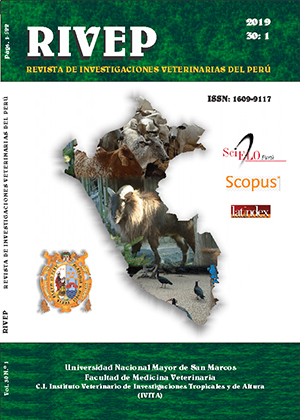Productive performance of broilers supplemented with tylosin phosphate or enramycin as growth promoters
DOI:
https://doi.org/10.15381/rivep.v30i1.15666Keywords:
tylosin phosphate; enramycin; growth promoters; broilers; productive performanceAbstract
The productive performance of broilers supplemented with tylosin phosphate and enramycin as growth promoters up to 42 days of age was evaluated. Four hundred male broilers were distributed into 4 treatments of 100 birds with 5 repetitions each. The treatments were: T1, control; diet without antibiotic; T2, diet with 8% enramycin in a dose of 10 ppm; T3, diet with enramycin 8% in a dose of 5 ppm; T4, diet with tylosin phosphate 25% in a dose of 55 ppm. The treated groups presented a higher body weight and better feed conversion index and European productive efficiency index than the control group; however, there were no differences in body weight gain, feed intake and mortality.
Downloads
Downloads
Published
Issue
Section
License
Copyright (c) 2019 Sandra Espinoza C., Pablo Reyna S., Eliana . Icochea D, Viviana San Martín, Nelly Giovanna Cribilleros B., Daniel Molina M.

This work is licensed under a Creative Commons Attribution-NonCommercial-ShareAlike 4.0 International License.
AUTHORS RETAIN THEIR RIGHTS:
a. Authors retain their trade mark rights and patent, and also on any process or procedure described in the article.
b. Authors retain their right to share, copy, distribute, perform and publicly communicate their article (eg, to place their article in an institutional repository or publish it in a book), with an acknowledgment of its initial publication in the Revista de Investigaciones Veterinarias del Perú (RIVEP).
c. Authors retain theirs right to make a subsequent publication of their work, to use the article or any part thereof (eg a compilation of his papers, lecture notes, thesis, or a book), always indicating the source of publication (the originator of the work, journal, volume, number and date).



